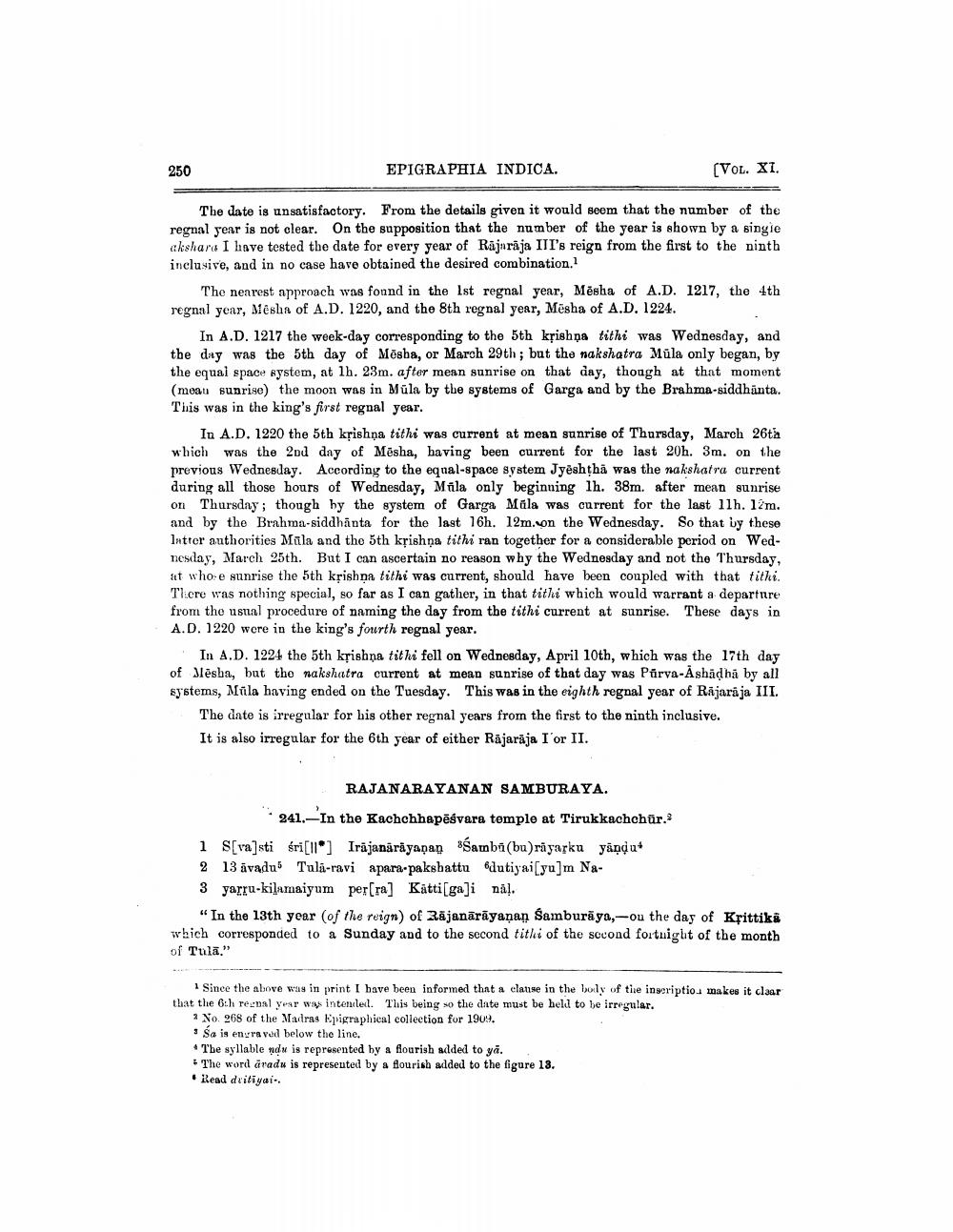________________
250
EPIGRAPHIA INDICA.
(VOL. XI.
The date is unsatisfactory. From the details given it would seem that the number of the regnal year is not clear. On the supposition that the number of the year is shown by a single akshars I have tested the date for every year of Rājarāja III's reign from the first to the ninth inclusive, and in no case have obtained the desired combination.
The nearest approach was found in the 1st regnal year, Měsha of A.D. 1217, the 4th regnal yonr, Meslin of A.D. 1220, and the 8th regnal year, Mesha of A.D. 1224.
In A.D. 1217 the week-day corresponding to the 5th krishọa tithi was Wednesday, and the day was the 5th day of Mēsba, or March 29th ; but the nakshatra Müla only began, by the equal space system, at lh. 23m. after mean sunrise on that day, though at that moment (meau sunrise) the moon was in Müla by the systems of Garga and by the Brahma-siddhanta. This was in the king's first regnal year.
In A.D. 1220 the 5th kşishņa tithi was current at mean sunrise of Thursday, March 26th which was the 2nd day of Mēsha, having been current for the last 20h. 3m. on the previous Wednesday. According to the equal-space system Jyėshthā was the nakshatra current during all those hours of Wednesday, Mīla only beginning lh. 38m. after mean sunrise on Thursday; though hy the system of Garga Māla was current for the last 11h. 12m. and by the Brahma-siddhanta for the last 16h. 12m.won the Wednesday. So that by these latter authorities Mūla and the 5th kņishņa tithi ran together for a considerable period on Wednesday, March 25th. But I can ascertain no reason why the Wednesday and not the Thursday, at who e sunrise the 5th krishna tithi was current, should have been coupled with that tithi Tl.cre was nothing special, so far as I can gather, in that tithi which would warrant a departure from the usual procedure of naming the day from the tithi current at sunrise. These days in A.D. 1220 were in the king's fourth regnal year.
In A.D. 1224 the 5th krishna tithi fell on Wednesday, April 10th, which was the 17th day of Jlēsba, but the nakshatra current at mean sunrise of that day was Pärva-Ashādha by all systems, Müla having ended on the Tuesday. This was in the eighth regnal year of Rājarāja III.
The date is irregular for his other regnal years from the first to the ninth inclusive. It is also irregular for the 6th year of either Räjaraja I'or II.
RAJANARAYANAN SAMBURAYA. * 241.-In the Kachchhapēsvara temple at Tirukkachchür. 1 S[va]sti sri[ll] Irājanārāyapan Bśarbi(bu)rāyarku yangu 2 13 ávadu Tula-ravi apara-paksbattu dutiyai yu]m Na3 yarru-kilamaiyum per[ra] Kätti[ga]i nal.
"In the 13th yoor of the reign) of Zājanārāyanan Samburaya,-ou the day of Krittika which corresponded to a Sunday and to the second title of the socond fortuight of the month of Tulā."
1 Since the above was in print I have been informed that a clatise in the body of the inscriptio. makes it clear that the 6th rezal year ww intenılel. This being so the date must be held to be irregular.
2 No. 268 of the Madras Epigraphical collection for 1909
Sa is engraved below the line. * The syllable ydw is represented by a flourish added to yā. . The word äradu is represented by a fourish added to the figure 13. Read driliyai.




